القرارات هي حقيقة من حقائق الحياة - سواء كان عليك أن تقرر ما الذي تريده على العشاء، أو المرشح الذي ستوظفه لشغل منصب رئيس قسم تكنولوجيا المعلومات، أو ما هي المنتجات التي ستطرحها في السوق هذا العام. نتخذ كل يوم خيارات يمكن أن تؤدي إلى تقدم أو تؤدي إلى عواقب.
وتقف وراء هذه القرارات عملية معقدة متعددة الخطوات.
إن تسخير التحكم في تلك العملية يمكّنك من اتخاذ القرارات ويؤدي إلى نتائج أكثر نجاحاً. فأنت لا تتعلم فقط كيفية اتخاذ قرارات رائعة، ولكنك تتعلم أيضًا من القرارات السيئة حتى لا ترتكب نفس الأخطاء مرتين.
مع هذا الدليل الخاص بعملية اتخاذ القرارات، ستتعلم سبع خطوات مهمة لاتخاذ قرارات أفضل. سنغطي الأنواع المختلفة من طرق اتخاذ القرارات التي يمكنك الاستفادة منها في عملك.
بالإضافة إلى ذلك، سنسلط الضوء على قوالب اتخاذ القرار لفريقك لتطوير منتجات مربحة وتحقيق أهداف الشركة. 👀
ما هي عملية اتخاذ القرار؟
عملية اتخاذ القرار هي إجراء تدريجي مصمم لإيجاد حلول للمشاكل بناءً على تجميع المعلومات وفحص الخيارات المختلفة واختيار كيفية المضي قدمًا.
بدءاً من تحديد المشكلة إلى مراجعة جميع الخيارات و
تنفيذ الخطة
للعمل، فإن عملية اتخاذ القرار المكونة من سبع خطوات مناسبة تمامًا لقرارات العمل وكذلك الخيارات الشخصية الأكثر تعقيدًا. 🌻

أنواع طرق اتخاذ القرار ## أنواع طرق اتخاذ القرار
هناك عدة أنواع مختلفة من النماذج الفعالة لاتخاذ القرارات، بما في ذلك النماذج العقلانية والإبداعية والبديهية - على سبيل المثال لا الحصر. ويعتمد اختيار النموذج المناسب على مستوى مهاراتك في اتخاذ القرار، ومقدار الوقت المتاح لك، وطبيعة القرار، واستراتيجيتك العامة في اتخاذ القرار.
فيما يلي تفصيل موجز للنماذج المختلفة لصنع القرار لمحاولة إيجاد الحلول الممكنة للعقبات التي تواجهك. 🤔
نموذج اتخاذ القرار العقلاني
يركز نموذج اتخاذ القرار العقلاني والمستنير على وضع جميع الحلول البديلة المختلفة بشكل منطقي. وهو النموذج الأكثر شيوعًا ولكنه قد يتطلب أيضًا الكثير من الوقت من حيث البحث.
باستخدام هذا النموذج، ستقوم بتحديد جميع الحلول المحتملة ثم العمل على إيجابيات وسلبيات كل منها لاتخاذ قرار فعال. إنه أفضل نموذج لمعالجة المشاكل التي لها تأثير كبير على المشاريع أو العمل ككل لأنه ينطوي على نهج مدروس ومنهجي.
نموذج اتخاذ القرارات البديهية
يدور النموذج الحدسي حول اتخاذ الخيارات بناءً على المشاعر والغرائز الغريزية. وهو مثالي في المواقف التي يوجد فيها قيود زمنية حيث يمكنك التصرف بسرعة
ومع ذلك، من الأفضل أن يكون هذا النهج مخصصًا للموظفين ذوي الخبرة في اتخاذ القرارات التجارية الذين تعاملوا مع مشاكل مماثلة من قبل. نظرًا لأنك لا تعمل مع البيانات، يجب أن تكون لديك خبرة سابقة في التعرف على الأنماط للاستفادة من ذلك بفعالية.
نموذج القرار القائم على التعرف على الأنماط
يمزج هذا النموذج بين مقاربات الأساليب العقلانية والبديهية، ولكن العامل المميز فيه هو أنك تقوم بتقييم حل واحد ممكن فقط، بدلاً من جميع البدائل المتاحة. إليك كيفية عمل هذا النموذج:
- تحديد المشكلة
- العمل من خلال الحل، وتصور التأثيرات والنتائج ذهنيًا
- وضع الخطة موضع التنفيذ، إذا كانت النتيجة المتوقعة مقبولة
مرة أخرى، هذا النموذج لصنع القرار هو الأنسب للخبراء وقادة الأعمال. وهو مثالي للاستخدام في المواقف التي يكون فيها ضغط الوقت.
نموذج اتخاذ القرار الإبداعي
يجمع نهج اتخاذ القرار هذا بين أجزاء من النموذج العقلاني والنموذج الحدسي. ويبدأ بجمع المعلومات عن المشكلة والخروج بحلول محتملة. وبدلاً من تحليل إيجابيات وسلبيات كل حل، فإنك تدع حدسك وعقلك الباطن يتوليان الأمر، ويقودانك إلى مسار عمل يتم اختباره بعد ذلك.
يعد هذا الحل التكراري لحل المشكلات مثاليًا للعصف الذهني وصناع القرار ذوي الخبرة مثل رواد الأعمال.
نموذج فروم-يتون لاتخاذ القرارات
نموذج نموذج فروم-يتون يستخدم سبعة أسئلة بنعم أو لا وخمسة أساليب فعالة لاتخاذ القرار لإرشادك إلى أفضل قرار. إنه أحد النماذج الأكثر تعقيداً حيث تحتاج إلى استخدام شجرة قرارات للوصول إلى الخيار الأفضل بناءً على كيفية إجابتك على الأسئلة والأسلوب الذي تختاره.
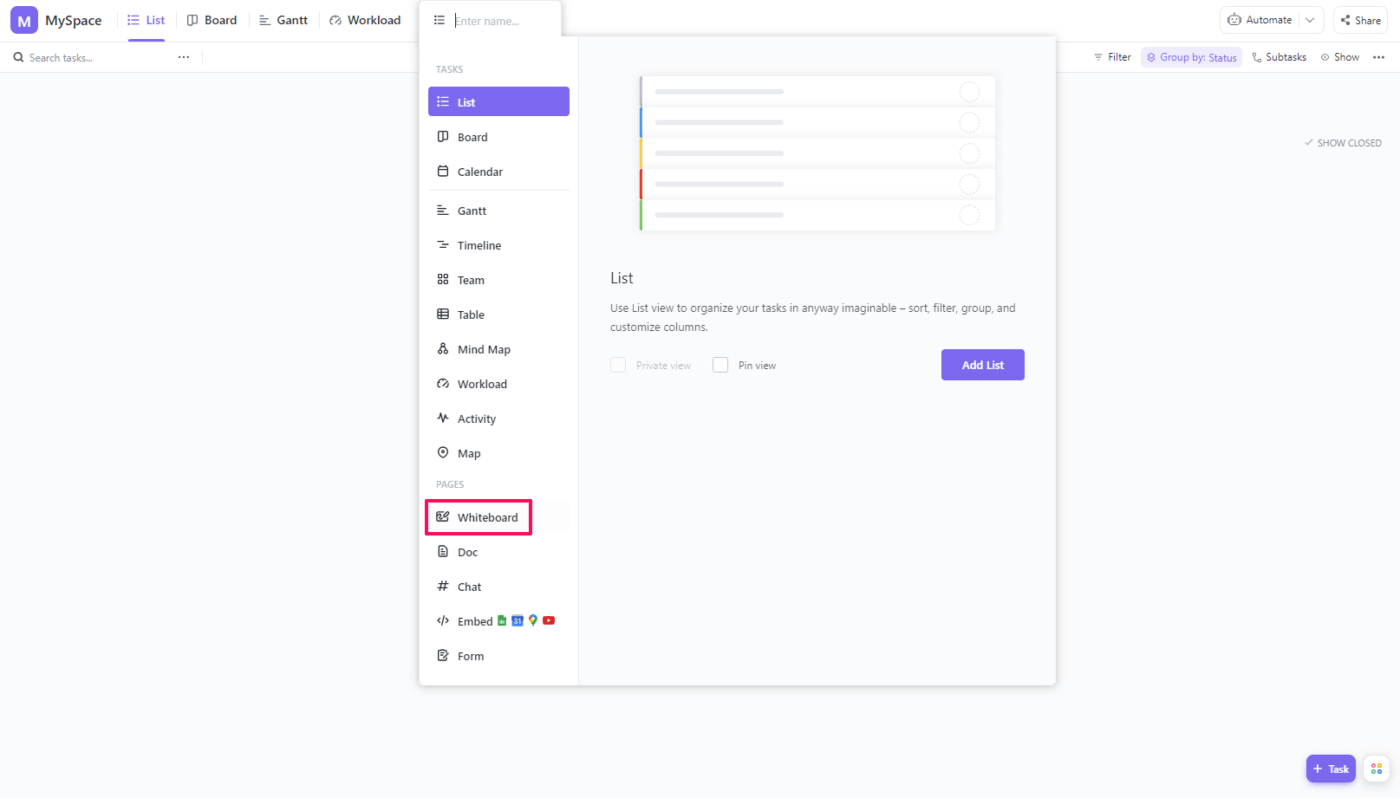
إنشاء سبورة بيضاء جديدة فارغة لبدء تصميم المخطط الخاص بك
هذا النموذج هو الأفضل للفرق واتخاذ القرارات التعاونية. يحتوي الإطار على خطوات مدمجة لتقسيم العمل وتعيين المسؤولية عن اتخاذ القرار.
7 خطوات في عملية اتخاذ القرار ## 7 خطوات في عملية اتخاذ القرار
هل أنت مستعد لاكتشاف طريقة أفضل لاتخاذ قرارات مستنيرة؟ اعمل من خلال هذا النموذج المكون من سبع خطوات في عملية اتخاذ القرار عندما تواجه معضلة صعبة. من جمع المعلومات إلى الموازنة بين جميع الخيارات، ستتخذ قرارات مستنيرة بشكل أفضل يمكنها أن تحرك الإبرة عندما يتعلق الأمر بأهدافك. ✨
1. حدد القرار الذي تحتاج إلى اتخاذه
أول شيء عليك القيام به هو تحديد القرار الذي تحاول اتخاذه. ربما تكون لديك عقبة في طريقك عندما يتعلق الأمر بـ تنفيذ المشروع أو ربما لديك نقص في الموارد.
مهما كان الأمر، فأنت بحاجة إلى تحديد المشكلة بوضوح و نطاق العمل قبل أن تبدأ في التفكير في الحلول. لمعرفة القرار الذي تحتاج إلى اتخاذه اسأل نفسك الأسئلة التالية:
- ما هي المشكلة المحددة؟ كن حذرًا من أن تكون واسعًا جدًا أو أن تجمع عدة مشاكل معًا. حدد ما هي المشكلة بالضبط وما هي أعضاء الفريق المتأثرين بشكل مباشر
- هل هناك هدف مرتبط بهذا القرار؟ حدد أولوية أي مشاكل مرتبطة مباشرة بأهداف المشروع. اجعل المشكلة قابلة للقياس حتى تتمكن من معرفة كيفية تأثيرها على الهدف بعد اتخاذ القرار
- كيف ستعرف ما إذا كان القرار قد أحدث تأثيراً؟ عند اتخاذ القرارات، فإنك تتوقع النتائج. اكتشف كيف ستقوم بتقييم ما إذا كان القرار الذي اتخذته صائباً أم لا
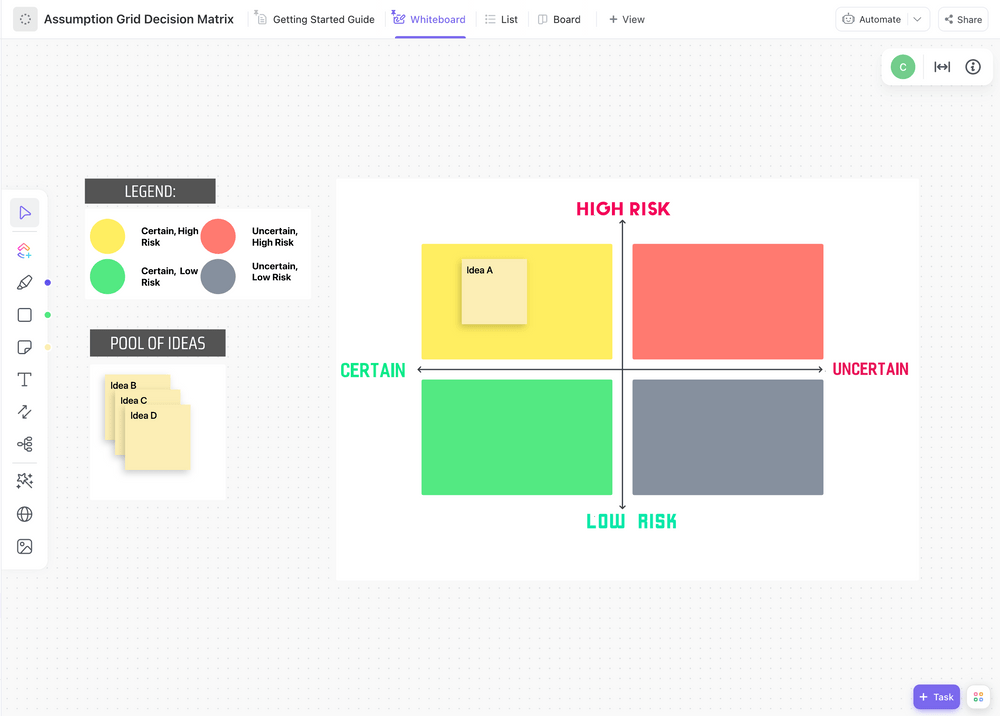
تساعدك مصفوفة قرار شبكة الافتراضات على تحديد أفضل النتائج بالمعلومات ذات الصلة لتحديد الحلول البديلة
2. جمع المعلومات داخلياً وخارجياً
إن اتخاذ قرارات مستنيرة أفضل دائمًا من مجرد اتخاذ خيار عشوائي. هذه الخطوة من عملية اتخاذ القرار أمر بالغ الأهمية لنجاحك.
ابدأ بجمع المعلومات ذات الصلة داخلياً. ابحث عن المواقف السابقة التي تعامل فيها فريقك أو شركتك مع مشكلة مماثلة وتوصلت إلى حل. قم بمراجعة وثائق المشروع لجمع الأفكار حول ما أدى إلى المشكلة المطروحة.
اعمل داخل قسمك وفي الأقسام ذات الصلة لجمع البيانات التاريخية حول المشاكل المماثلة والقرارات المرتبطة بها. استعرض تجاربهم السابقة ولاحظ أي رؤى أو معلومات ذات صلة.

استخدم خاصية ClickUp Docs للتعاون مع فريقك وجمع المعلومات بشكل أكثر فعالية
ثم انتقل إلى خارج مؤسستك للعثور على المعلومات المتاحة. تعتبر أبحاث السوق طريقة ممتازة لمعرفة ما إذا كان المنافسون يواجهون مشاكل مماثلة. راجع الدراسات وفكر في العمل مع استشاري إذا كنت تريد المزيد من المعلومات أو الخبرة.
3. تحديد الحلول المحتملة
بمجرد حصولك على جميع المعلومات اللازمة، حان الوقت للبدء في مراجعة الخيارات المتاحة. في معظم الحالات، سيكون هناك أكثر من حل محتمل للمشكلة. وسيعتمد اتخاذ القرار الصحيح على احتياجات شركتك وبيئة السوق في أي وقت من الأوقات.
على سبيل المثال، لنفترض أنك تعمل كمدير مشروع تسويقي وهدفك في هذا الربع هو زيادة التحويلات بنسبة 300%. قد تكون خياراتك المحتملة هي الاستثمار في الإعلانات المدفوعة أو إنشاء محتوى مدونة جديد أو تشغيل حملات على وسائل التواصل الاجتماعي.
هناك أيضًا سيناريوهات قد تختار فيها بضعة نماذج أو حلول مختلفة لاتخاذ القرار بدلاً من مسار عمل واحد فقط. كن حذرًا من التحيزات - خاصةً إذا كنت قد عملت على مشكلة مماثلة في الماضي.
فقط لأن حلاً ما نجح مرة واحدة من قبل لا يعني أنه الخيار الأفضل دائمًا في مواقف مماثلة. ✍️
4. وازن بين أدلة كل خيار
الآن بعد أن عرفت خياراتك، حان الوقت للبدء في موازنة الأدلة لمعرفة أفضل مسار للعمل. افحص كيف استجابت شركتك أو منافسيك لمواقف مماثلة في الماضي.
ضع قائمة بالإيجابيات والسلبيات لكل خيار من الخيارات. ضع في اعتبارك ما إذا كان أي منها يقدم مكافآت إضافية إلى جانب حل المشكلة المطروحة. للقيام بذلك، استخدم نماذج التخطيط الاستراتيجي وأساليب مثل تحليل SWOT و مصفوفات القرار .
5. اتخاذ القرار النهائي
حان الوقت الآن لاتخاذ القرار النهائي واختيار مسار العمل. استناداً إلى المعلومات التي جمعتها ومراجعتك لجميع الخيارات، قرر كيف تريد المضي قدماً.
ربما ستجمع بين جوانب عدة حلول مختلفة. ربما ستختار نهجاً واحداً محدداً لحل المشكلة. فكر في جميع الأدلة، وراجع البدائل، واختر الحل الأفضل.
6. اتخذ إجراءً بشأن قرارك
لقد أخذت الوقت والجهد اللازمين لمراجعة خياراتك واتخذت قرارك. بعد ذلك، تحتاج إلى وضع خطة ووضعها موضع التنفيذ.
قم بإنشاء خطة مشروع تحدد أصحاب المصلحة المتأثرين وأعضاء الفريق الذين سيلعبون دورًا في المشروع. معالجة تخصيص الموارد وتخطيط الميزانية لتشمل حلولك الجديدة. تحديد أولويات المشاريع والمهام وتسليط الضوء على أي تبعيات قد تؤثر على نتيجة مسار عملك.
قم بإنشاء إطار واضح للتوقعات لجميع أعضاء الفريق، وحدد صانعي القرار في مرحلة العمل. كما قال كريس سمول، نائب رئيس شركة ساوند سترايب "يكون التواصل سهلاً عندما تكون هناك قناة واحدة فقط بين القرار والفعل."
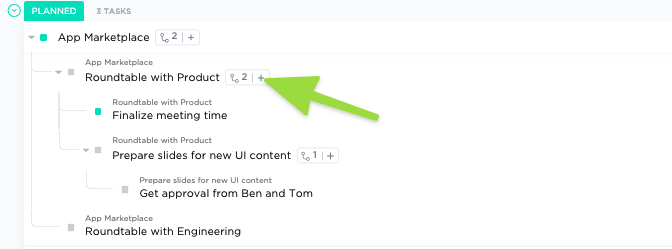
قسّم خطة عملك إلى مهام معينة ومهام فرعية ومهام فرعية متداخلة في ClickUp
قسّم المهام إلى مراحل يسهل إدارتها وتأكد من إعلام الجميع بمن هو المسؤول عن القرارات والإجراءات. ✅
7. إجراء مراجعة
في الخطوة الأولى، قمت بوضع مقاييس ومعايير تقييم لحلول المشكلة. قم بقياس ما إذا كنت قد اتخذت القرار الصحيح من خلال إجراء مراجعة لعملية اتخاذ القرار.
إليك بعض الأسئلة التي يجب أن تطرحها على نفسك في نهاية عملية اتخاذ القرار:
- هل اتخذت قراراً صائباً؟
- هل كان للقرار أي آثار سلبية؟
- كيف أثر القرار على أصحاب المصلحة؟
- هل كان هناك حل أفضل؟
- هل تم حل المشكلة؟
- أين كان بإمكانك القيام بعمل أفضل في عملية اتخاذ القرار؟
إن اتخاذ الإجراءات أمر مهم، ولكن تخصيص وقت لمراجعة قراراتك لا يقل أهمية عن ذلك. قم بجدولة مراجعة عملية اتخاذ القرار في الجدول الزمني للمشروع لجمع المعلومات حول ما نجح وما لم ينجح. التعاون مع أعضاء الفريق لمناقشة وجهات نظرهم حول العملية والنتائج.
نماذج اتخاذ القرار لفريقك ## نماذج اتخاذ القرار لفريقك
هل أنت مستعد لتنفيذ عمليات جيدة لاتخاذ القرارات؟ هذه القوالب الخاصة باتخاذ القرارات من ClickUp تجعل الحياة أسهل سواء كنت مالكاً مسؤولاً عن اتخاذ القرارات التجارية أو مدير مشروع يقود فريق عمل رائع. 💪
1. وثيقة إطار عمل اتخاذ القرار
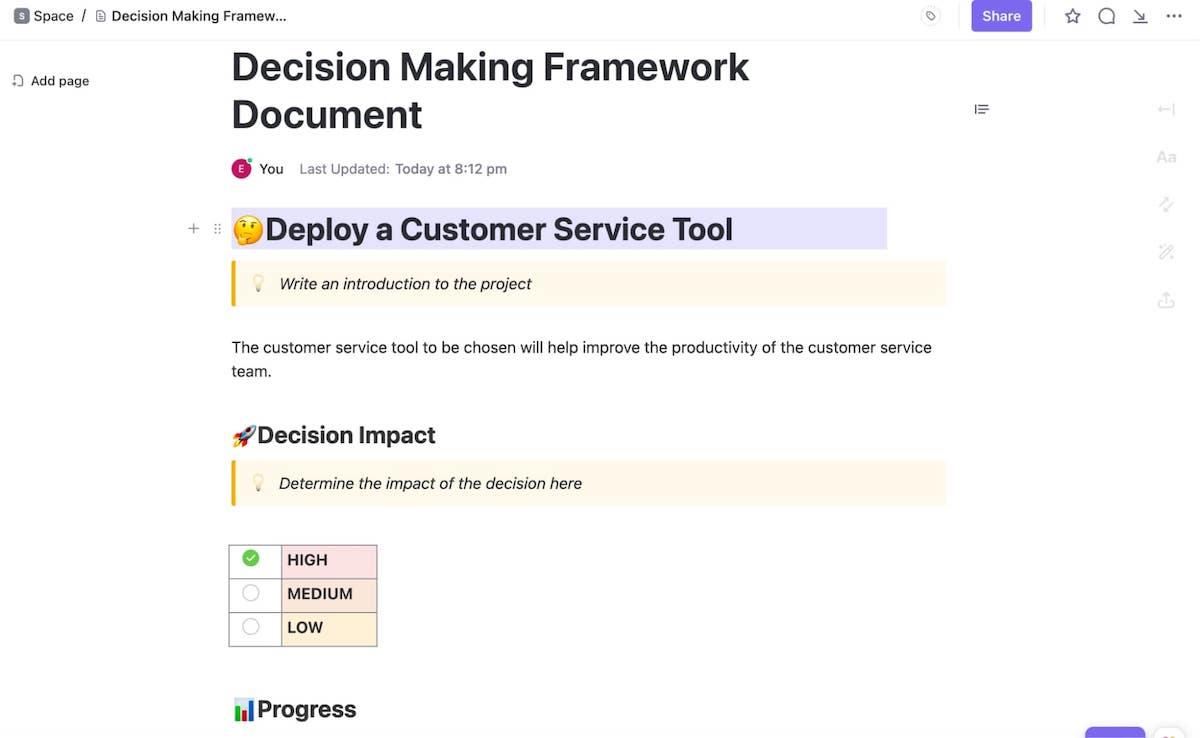
إنشاء خريطة طريق لصنع القرار وتأثيرات المشروع مع وثيقة إطار عمل صنع القرار من ClickUp
إن وثيقة إطار عمل اتخاذ القرار من ClickUp طريقة سهلة لإنشاء دراسة لحل مشكلة ما واختيار الحل الأفضل.
قم بتعبئة خطوات النموذج بما في ذلك تحديد المشكلة والحلول المحتملة وتأثيراتها على العمل. يتيح لك إطار العمل وضع جميع أفكارك في مكان واحد، مما يسمح بتحليل أفضل.
2. شجرة القرار
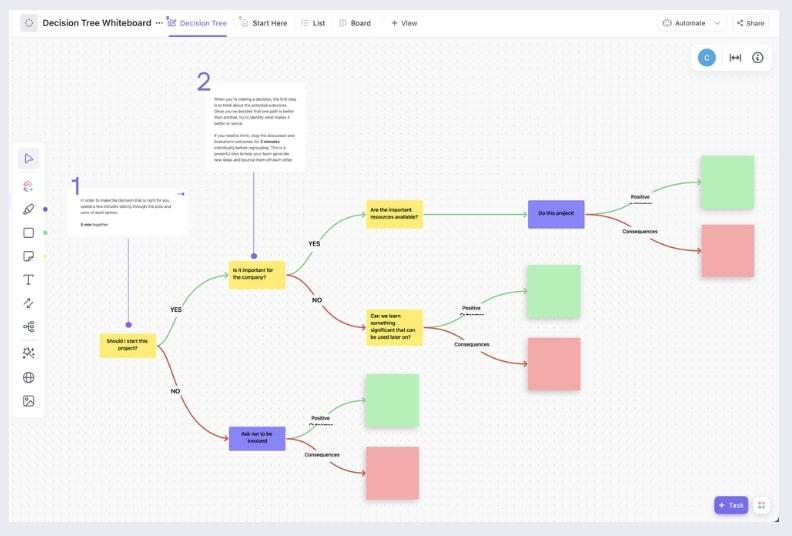
حدد الخيارات التي يمكنك القيام بها ونتائجها المحتملة باستخدام قالب شجرة القرار ClickUp Decision Tree
استخدم شجرة قرارات ClickUp لتخطيط الخيارات والحلول الممكنة على لوحة بيضاء مرئية. هذا القالب مثالي للفرق التي تتطلع إلى تعزيز المناقشات الداخلية حول أفضل الأساليب.
تجعل الخطوات المرمزة بالألوان من السهل تحديد العوائق والتحديات خلال العملية. والأفضل من ذلك كله، تم تصميم القالب ليكون تعاونياً، بحيث يمكنك الحصول على مدخلات من مختلف أعضاء الفريق عبر الأقسام.
3. سجل قرارات إدارة المشروع
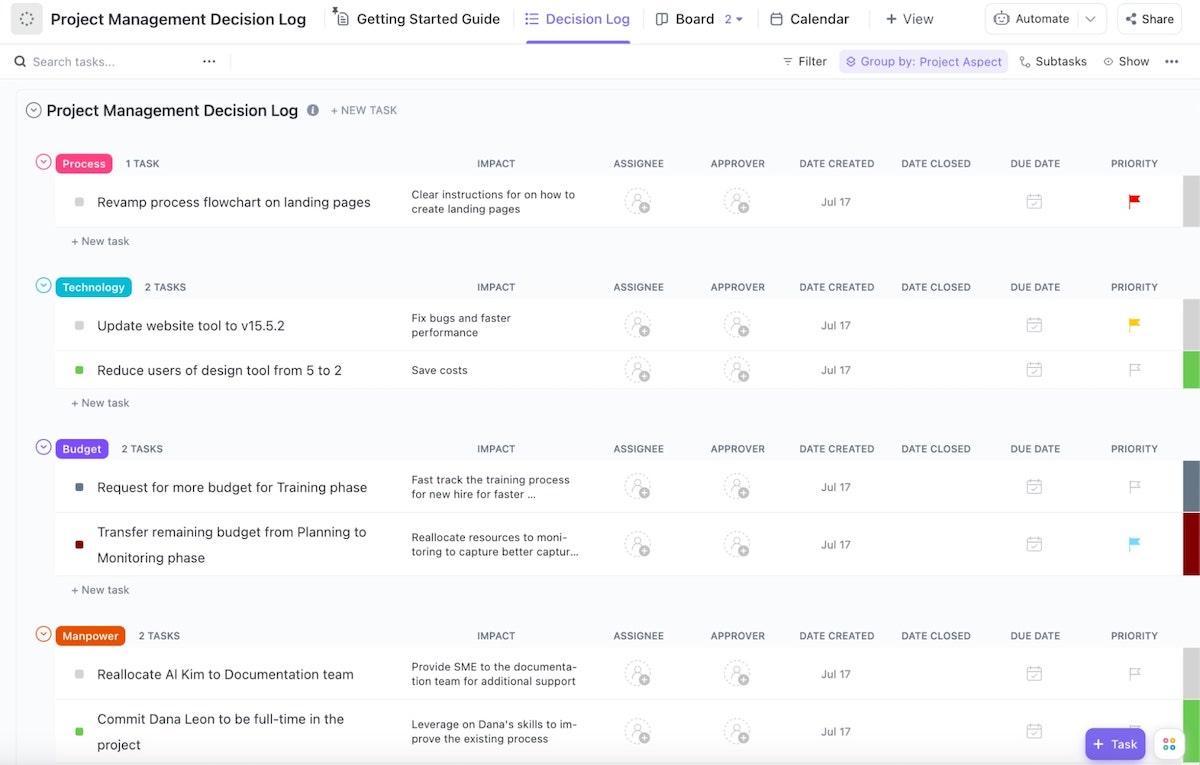
استخدم سجل قرارات إدارة المشاريع الخاص ب ClickUp لتصنيف كل خطوة في عملية اتخاذ القرار الخاصة بك
مع سجل قرارات إدارة المشاريع في Clickup تسجيل وتتبع جميع عمليات اتخاذ القرار في لوحة تحكم سهلة الإدارة. خمسة خيارات مختلفة للحالة وثلاثة حقول مخصصة تجعل من السهل معرفة مرحلة العملية التي يمر بها كل قرار.
تتيح لك أنواع العرض الأربعة الفرز حسب التقويم لمعرفة ما يحدث الآن أو عرض لوحة القرارات للحصول على نظرة عامة أوسع.
4. سجل القرار

يسهّل سجل القرارات الشامل من ClickUp مراقبة وتقييم عملية اتخاذ القرارات داخل الأقسام والمشاريع وعلى مستوى الشركة
توثيق معايير اتخاذ القرار، ومراقبة التقدم المحرز، وتقييم النتائج باستخدام سجل قرارات ClickUp . تم تصميمه كأداة شاملة، وهو مثالي لإدارة عملية اتخاذ القرار العقلاني من البداية إلى النهاية. استخدمه لإنشاء خطة لحل المشاكل داخل الأقسام، وعلى مستوى الشركة، وفي مشاريع محددة.
إتقان عملية اتخاذ القرار باستخدام ClickUp
أنت تتخذ القرارات كل يوم، وفي مجال الأعمال التجارية، يعد اتخاذ القرارات عنصراً حاسماً لتحقيق الأهداف. يعد قضاء الوقت في اختيار النهج الصحيح بناءً على احتياجات عملك المحددة أمرًا ضروريًا سواء كنت مدير مشروع أو رائد أعمال.
وسواء كنت تتخذ قرارات مهمة تؤثر على صافي أرباح الشركة أو تبحث عن طرق مبتكرة لخدمة عملائك، فمن الضروري أن تفكر مليًا في القرارات التي تتخذها. قد يؤدي التسرع في اتخاذ القرارات إلى ارتكاب الأخطاء، لكن العمليات المناسبة مثل إطار العمل المكون من سبع خطوات والطرق المذكورة أعلاه يمكن أن تساعدك في جعلك صانع قرار أفضل.
هيئ نفسك وفريقك للنجاح، و ابدأ باستخدام ClickUp لتمكين عمليات اتخاذ القرارات الخاصة بك. من القوالب التي تسهل عليك تسجيل القرارات إلى أشجار القرارات لتخطيط عملية التفكير الخاصة بك، ستجد طرقًا لا حصر لها لاتخاذ القرارات بشكل أكثر فعالية. 🙌

